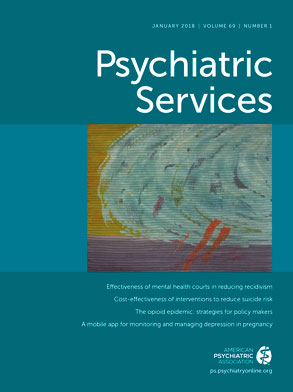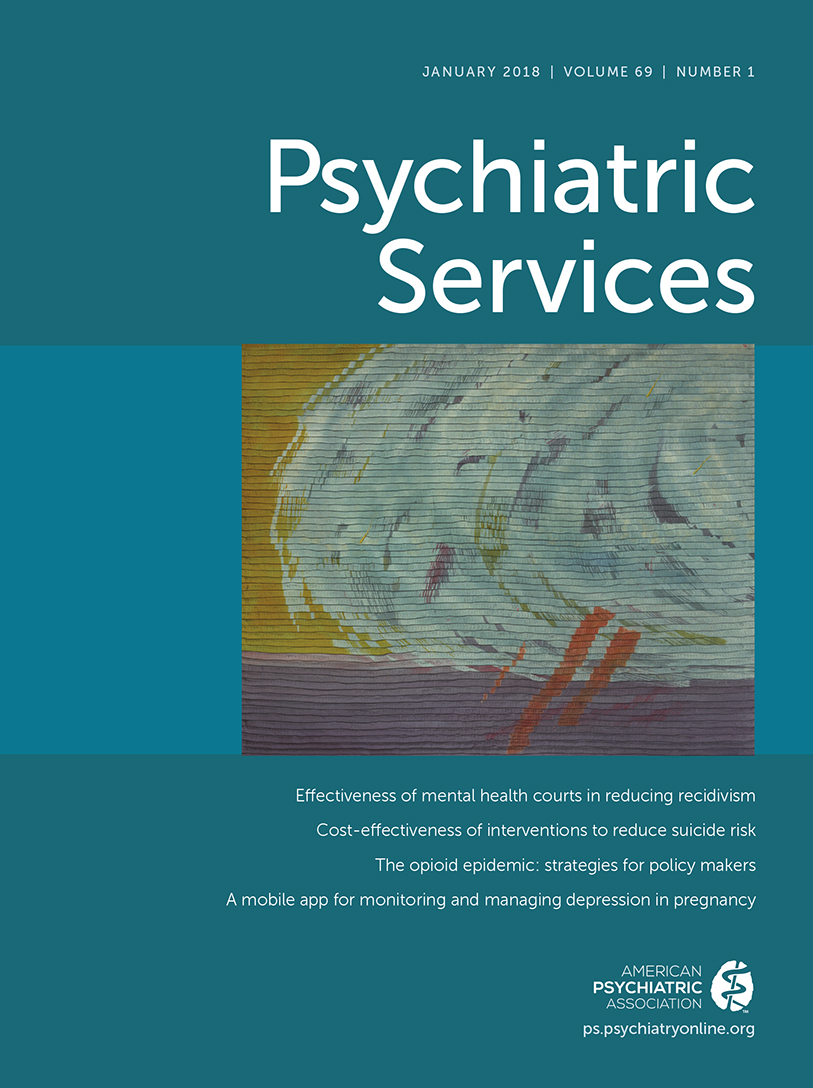The efficient allocation of clinical resources is an important issue in health systems that affects cost and the ability to deliver care in response to real-time changes in demand (
1). Inpatient psychiatric consultation-liaison (CL) services provide an example of these challenges in practice. Because consultation requests vary in nature and urgency, accurately matching staffing levels and expertise with demand for services is difficult. Psychiatric CL services are integral to inpatient medical and surgical care, providing a broad range of support—from management of psychiatric symptoms to suicide safety assessments and placement of psychiatric holds. Many hospitals, especially smaller, community-based facilities, do not have sufficient demand or resources to support full-time psychiatric staff but have urgent, intermittent needs (
2). Staffing models based on fixed levels and time periods can be inefficient, limiting the ability to respond to surges in demand yet creating an oversupply of providers when demand is low. This kind of inefficiency affects specialty services across disciplines in medicine, where providers cluster in quaternary or specialty care sites due to pooling of demand for services at those locations yet have low availability elsewhere (
3).
Telemedicine has been increasingly adopted in many settings and has the potential to address some of these challenges. With a focus on the verbal interview as the primary source of information from patients, psychiatry is well suited for telemedicine, which has been implemented in a variety of psychiatric settings, including outpatient clinics, emergency departments, and rural facilities (
4). However, there has been only one prior report of telemedicine use for inpatient psychiatric CL services (
5). Inpatient CL differs from typical outpatient settings in ways that may affect the use of this technology, including the acute nature of consultations, co-occurring medical issues, and varying levels of patients’ alertness and mobility. New technologies are promising yet are challenged by implementation barriers such as complexity, cost, and the need to adapt services to take advantage of technologies in ways that are relevant to organizational needs (
6,
7). In relation to CL psychiatry and health care more generally, it is not clear which care delivery models supported through telemedicine may improve both overall capacity and flexibility in responding to variable demands for services.
We describe an implementation of telemedicine that used simple, low-cost technologies and explore its potential to engage providers across areas of expertise and locations to improve capacity to respond to demand for psychiatric services in the inpatient CL setting.
Methods
We implemented telemedicine for inpatient psychiatric CL services at a community-focused, 256-bed secondary care hospital located approximately four miles from the primary University of California, Los Angeles (UCLA) quaternary care campus. CL services had been provided by a general adult psychiatrist available on site daily for four-hour periods. The planning phase spanned five months and involved engagement of key stakeholders, including nurses, physicians, administrators, and technology staff.
A series of 10 stakeholder planning meetings were conducted to discuss technology options, perceptions of telemedicine for inpatient services, and workflow processes. As nursing staff desired more involvement with the telemedicine encounters, we adapted the planned workflow to rely on direct communication between the consultant and charge nurse to set up telemedicine sessions. There was also an interest in using simple, low-cost technologies. Therefore, we used Cisco WebEx for encrypted, HIPAA-compliant videoconferencing services and iPad mini-tablets distributed to inpatient units.
We conducted a phased, unit-by-unit rollout over approximately six months with ongoing stakeholder meetings. Telemedicine was available as an additional method for patient contact, enabling the staff psychiatrist to spread the four-hour availability throughout the day. During the initial rollout with 31 patients, acceptability of telemedicine was assessed through use of experience surveys for patients (five items) and nurses (three items). Once telemedicine was introduced to all units, an on-demand staffing model was implemented to create a virtual consultant pool from existing psychiatry faculty to supplement the staff psychiatrist. Consultants were provided a fixed rate for services, with insurance reimbursements pooled at the department level. All procedures were approved by the UCLA Institutional Review Board. Data were collected from January 2014 through May 2015.
Results
A total of 94 telemedicine encounters were completed for 80 patients (ages 19–102, mean 65.4 years). Of the 69 patients who had an initial evaluation conducted via telemedicine, 45 (65%) did not require a follow-up encounter, 13 (19%) had one or more telemedicine follow-up encounters, and 16 (23%) had one or more in-person follow-up encounters. There were no cases where an in-person evaluation was required in addition to the telemedicine encounter to answer the consulting question. There was a broad range of consulting issues, including delirium and altered mental status (33%, N=26), depression and suicide safety assessments (33%, N=26), capacity evaluations (9%, N=11), and psychosis (10%, N=8). Only one patient refused to be seen via telemedicine because of paranoia about the technology. The nursing staff found the coordination (71%, N=17 of 24 nurses surveyed) and setup process (71%, N=17) very easy or easy to complete. Nurses reported that they felt the patient experience was generally positive, including excellent or above average (58%, N=14) and average (25%, N=6). The most common issues identified by patients were difficulty with hearing or seeing the consultant (28%, N=7 of 25 patients surveyed). Despite this drawback, 88% (N=22) of patients agreed or strongly agreed that they could communicate adequately with the consultant. For patient satisfaction, 72% (N=18) of patients agreed or strongly agreed that they were very satisfied with the telemedicine session, yet 64% (N=16) agreed or strongly agreed that they would prefer to see a provider in person.
Using a virtual pool of seven psychiatrists, we implemented an on-demand staffing model and completed consultations for 49 patients. Consultants included three geriatric psychiatrists, two general adult psychiatrists, and two psychiatrists with a focus on substance abuse. Two models were explored in distributing consultation requests. In the first model, we alerted the entire pool to each request and assigned the request to the first consultant who responded. Requests for patient follow-ups would return to the pool; thus a patient could be seen by a different consultant. This method was challenging to operationalize given the relatively small number of consultants with limited availability. We then modified the model to include a minimum time commitment by consultants (agreement to complete at least one new consultation per week), and the staff psychiatrist assigned consultations to individuals in the pool and attempted to align requests with consultant expertise (for example, geriatric consultations assigned to the geriatric psychiatrists). In addition, the consultant performing the initial evaluation would be responsible for subsequent follow-up encounters. This model resulted in improved assignments of consultations, although we did not systematically track these outcomes.
A Simple, Low-Tech Approach for Telemedicine Services
This implementation process for telemedicine used simple, consumer-grade technologies paired with an on-demand clinical service model to deliver inpatient psychiatric CL services. Although telemedicine has been used in a variety of psychiatric settings, there has been only one previous report of its implementation for inpatient psychiatric CL services (
5). Our experience is consistent with DeVido et al.’s, with telemedicine applicable for a broad range of CL issues. We also evaluated the acceptability of telemedicine in this setting. Interestingly, despite reporting high satisfaction with their telemedicine experience, most patients reported a preference to be seen in person. This response may be related to the fact that advantages of telemedicine typically reported when used in outpatient settings—decreased travel cost and wait times for an appointment—do not apply in this setting (
8).
Our success in implementation may partly be a result of the familiarity of staff with the consumer-grade technologies chosen (as opposed to specialized telemedicine carts or robots) and an implementation process beginning with engagement of stakeholders in the health system to co-develop the technology implementation plan, including consideration for workflow processes. Both perceived ease of use (
9) and early, meaningful engagement of stakeholders (
10) are key factors in technology adoption. This may be particularly relevant for community-based facilities with limited technical support and budget; an engaged implementation process utilizing simple, low-cost technologies may improve the feasibility of implementing and maintaining these systems.
Increasing Capacity and Responding to Demand in Real Time
Telemedicine paired with the on-demand model enabled us to increase both the number of consultants and the breadth of expertise available to provide CL services. Even though consultants had existing full-time duties, the flexibility and limited time commitment needed for individual consultations enabled utilization of shorter periods of availability (30–90 minutes) than would have been possible if travel were required. Therefore, these types of staffing models may support increased capacity for psychiatric services from providers who may have only shorter intervals of available time, similar to efficiencies gained in expanding workforces with ride sharing and other on-demand services. Evaluating cost-effectiveness of telemedicine compared with in-person staffing for on-demand models is an important future direction. Costs would depend on the volume of consultations, number of providers in the pool, distance between sites, and other factors, such as the cost of telemedicine equipment and time to set up remote encounters. This focus on how technologies and services may be adapted together is also a practical example of recent recommendations for framing the use of technology-enabled services in mental health (
7), including a focus on improving service delivery through technologies; creating cohesive services through consideration of the roles of providers, patients, and technologies; and designing and evaluating these service within health system settings.
Telemedicine also has potential to modify incentive mechanisms for on-demand and other technology-enabled services. While many states have laws supporting parity in reimbursement for telemedicine equal to that for traditional care, restrictions remain related to certain payers and situations. We addressed this inconsistency by using a fixed payment rate for providers and pooling reimbursements at the department level, which eliminated the risk of variable reimbursements for providers. In addition to these financial incentives, other incentive options may be explored, such as gamification, behavioral notifications, dynamic payment rates, and peer-based performance comparisons. Pooling requests from different locations and services (emergency departments, same-day appointments, and inpatient consultations) may offer additional efficiencies. A high level of demand could allow for the staffing of full- or part-time providers, with the use of an on-demand virtual pool to address surges in demand or specialized needs such as subspecialty consultations. Future studies will be needed to evaluate the efficiency and cost-effectiveness of different combinations of incentives and staffing models (fixed versus on demand) given various parameters within health systems, such as availability of providers, reimbursement rates, and urgency of demand.
It is not clear how a limited on-site presence may affect the ability to provide informal staff liaison and the perception of access to consultants. There may be opportunities for creating virtual spaces, such as online office hours, or creating hybrid models that engage other mental health professionals, such as social workers, for in-person support. It is possible to imagine new ways of creating interdisciplinary teams, where “colocation” takes on new meaning and virtual networks of individuals could provide collaborative care across specialties, roles, and locations.
How training programs for physicians, nurses, social workers, and others, including hospital administrators, may need to be modified to further support adaptation and implementation of novel technologies and services are additional issues to explore.
Conclusions
As technologies such as telemedicine continue to advance, it is important to consider how we might take advantage of their strengths while addressing challenges in adapting service delivery models to patient, provider, and health system priorities. Ultimately, this may improve critical issues in health services delivery, such as responding to urgent demands and increasing access to limited services, especially in underresourced settings.
Acknowledgments
The authors thank the staff and administration of UCLA Medical Center Santa Monica, UCLA Health, and Semel Institute for Neuroscience and Human Behavior for their partnership and support in these efforts.

